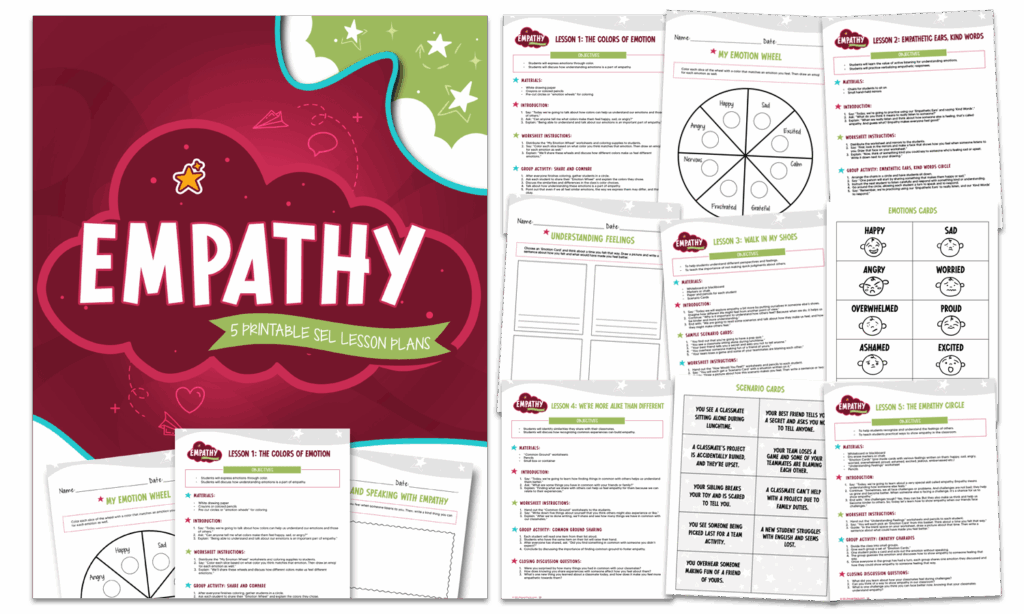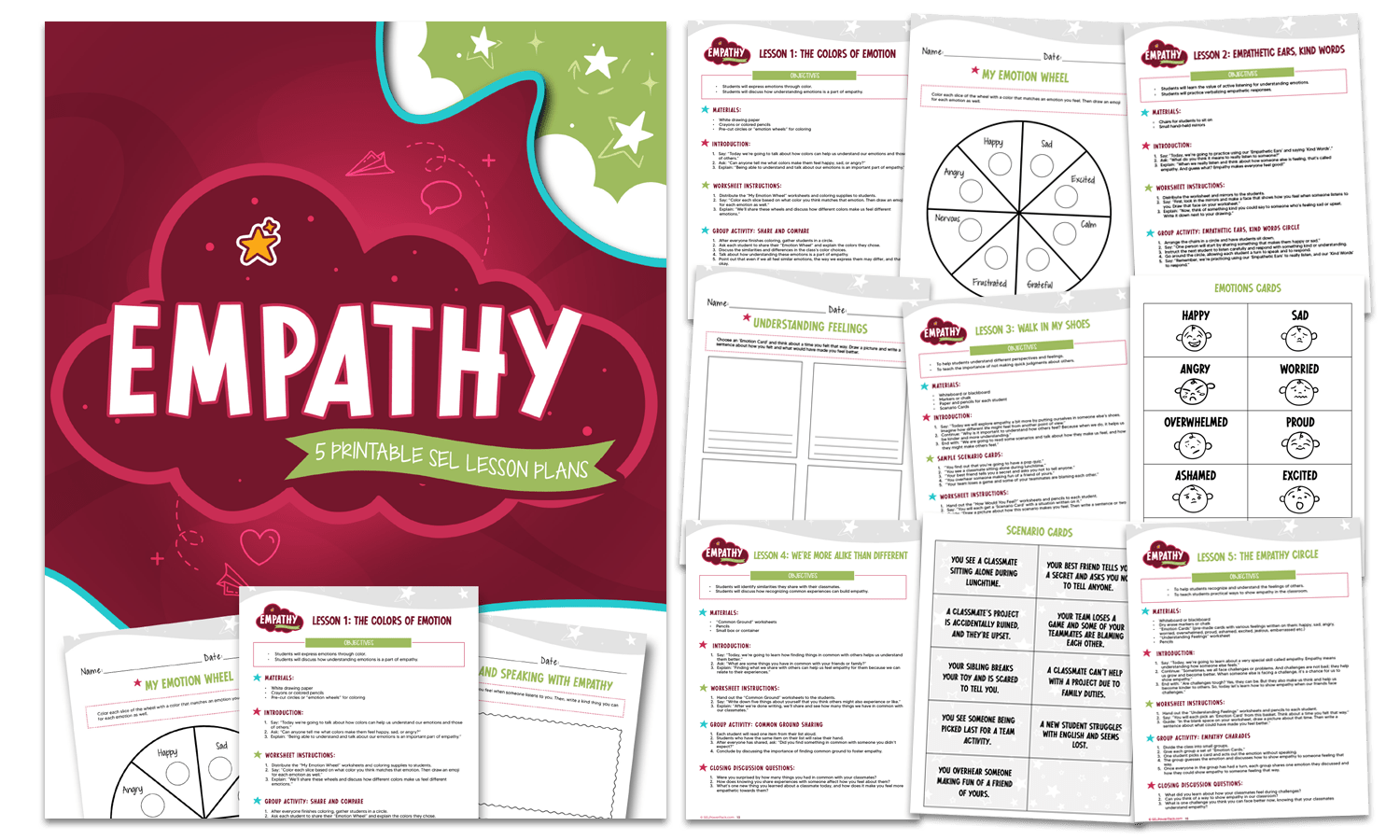
Cultivating Kindness: Essential Lessons on Empathy for Elementary Students
In an increasingly interconnected world, teaching children empathy is more crucial than ever. Empathy, the ability to understand and share the feelings of another, is a cornerstone of social-emotional learning and plays a vital role in fostering positive relationships, preventing bullying, and creating a more compassionate society. This article explores practical and engaging lessons on empathy for elementary students, providing educators and parents with valuable tools to cultivate kindness and understanding in young learners. These lessons on empathy for elementary students are designed to be age-appropriate, interactive, and easily integrated into existing curricula. By focusing on real-world scenarios and thought-provoking activities, we can help children develop the skills necessary to navigate complex social situations and build meaningful connections with others. These lessons on empathy for elementary students will cover various topics, from identifying emotions to perspective-taking, and will provide actionable strategies for promoting empathy in the classroom and at home.
Why Empathy Matters in Elementary Education
Empathy is not just a nice-to-have trait; it is a fundamental skill that benefits children in numerous ways. Research has shown that children who demonstrate empathy are more likely to have stronger social skills, perform better academically, and experience greater emotional well-being. Teaching lessons on empathy for elementary students can lead to a more inclusive and supportive classroom environment.
- Improved Social Skills: Empathy helps children understand and respond appropriately to the needs and feelings of others, leading to healthier relationships and reduced conflict.
- Enhanced Academic Performance: Studies have linked empathy to improved academic outcomes, as children who are empathetic are better able to collaborate with peers and understand different perspectives.
- Reduced Bullying: Empathy is a powerful antidote to bullying. When children can understand the impact of their actions on others, they are less likely to engage in harmful behavior.
- Increased Emotional Well-being: Empathy allows children to connect with others on a deeper level, fostering a sense of belonging and reducing feelings of isolation.
Core Components of Empathy Lessons for Elementary Students
Effective lessons on empathy for elementary students should incorporate several key components. These include:
Identifying and Understanding Emotions
The first step in developing empathy is being able to recognize and understand emotions, both in oneself and in others. Activities that focus on identifying facial expressions, body language, and tone of voice can help children develop this crucial skill. For example, teachers can use picture cards depicting different emotions and ask students to identify and discuss what might be causing those feelings. Lessons on empathy for elementary students should incorporate activities that encourage emotional literacy.
Perspective-Taking
Perspective-taking involves understanding a situation from another person’s point of view. This skill is essential for developing empathy, as it allows children to see the world through someone else’s eyes. Role-playing exercises, storytelling, and discussions about different perspectives can help children develop this ability. For instance, a teacher might present a scenario where two characters have conflicting opinions and ask students to consider the reasons behind each character’s viewpoint. These lessons on empathy for elementary students help kids understand different perspectives.
Emotional Regulation
While empathy involves understanding and sharing the feelings of others, it’s also important to teach children how to manage their own emotions in response to those feelings. Emotional regulation skills, such as deep breathing and positive self-talk, can help children avoid becoming overwhelmed by the emotions of others and respond in a constructive way. Lessons on empathy for elementary students should include strategies for managing emotional responses.
Active Listening
Active listening is a crucial component of empathy. It involves paying attention to what someone is saying, both verbally and nonverbally, and responding in a way that shows you understand and care. Teachers can model active listening skills by giving students their full attention, making eye contact, and asking clarifying questions. Students can also practice active listening through partner activities, where they take turns sharing their thoughts and feelings and responding to each other with empathy. These lessons on empathy for elementary students will reinforce the importance of active listening.
Engaging Activities for Teaching Empathy in Elementary School
There are numerous engaging activities that can be used to teach lessons on empathy for elementary students. Here are a few examples:
Emotion Charades
In this activity, students act out different emotions while their classmates guess what they are feeling. This helps children develop their ability to recognize and interpret nonverbal cues.
Storytelling and Role-Playing
Reading stories that explore different perspectives and emotional experiences can be a powerful way to teach empathy. After reading a story, students can participate in role-playing activities, where they act out scenes from the story and explore the characters’ emotions. Lessons on empathy for elementary students can greatly benefit from storytelling and role-playing.
“Walk in My Shoes” Exercises
These exercises involve asking students to imagine what it would be like to be in someone else’s situation. For example, a teacher might ask students to imagine what it would be like to be a new student at school or to have a disability. This helps children develop their perspective-taking skills and understand the challenges faced by others. These are valuable lessons on empathy for elementary students.
Empathy Journals
Encouraging students to keep empathy journals, where they reflect on their own emotions and the emotions of others, can help them develop greater self-awareness and empathy. Students can write about times when they felt empathetic towards someone or when they observed someone else showing empathy. This can be a great addition to lessons on empathy for elementary students.
Community Service Projects
Participating in community service projects can provide students with opportunities to put their empathy skills into action. By volunteering their time to help others, children can develop a greater understanding of the needs of their community and the importance of giving back. This could be a practical application of lessons on empathy for elementary students.
Integrating Empathy Lessons into the Curriculum
Lessons on empathy for elementary students don’t have to be taught in isolation. They can be integrated into various subjects, such as language arts, social studies, and even math. For example:
- Language Arts: When reading novels or short stories, focus on the characters’ emotions and motivations. Ask students to consider how the characters might be feeling and why they are behaving in certain ways.
- Social Studies: When studying different cultures or historical events, emphasize the importance of understanding different perspectives and respecting cultural differences.
- Math: Use word problems that involve real-world scenarios and require students to consider the needs of others.
The Role of Parents in Fostering Empathy
While schools play a crucial role in teaching empathy, parents also have an important role to play. Parents can foster empathy in their children by:
- Modeling Empathy: Children learn by observing the behavior of their parents. Parents who demonstrate empathy in their own interactions with others are more likely to raise empathetic children.
- Encouraging Discussion: Parents can encourage their children to talk about their feelings and the feelings of others.
- Reading Together: Reading books that explore different perspectives and emotional experiences can be a great way to foster empathy.
- Volunteering as a Family: Participating in community service projects as a family can provide children with opportunities to put their empathy skills into action.
Addressing Challenges in Teaching Empathy
Teaching lessons on empathy for elementary students can sometimes be challenging. Some children may struggle to understand the emotions of others, while others may have difficulty managing their own emotional responses. It’s important to be patient and understanding and to provide children with the support they need to develop these skills.
One common challenge is children confusing empathy with sympathy. Empathy involves understanding and sharing the feelings of another, while sympathy involves feeling sorry for someone. It’s important to help children understand the difference between these two concepts and to encourage them to develop empathy rather than sympathy.
Measuring the Impact of Empathy Lessons
It’s important to measure the impact of lessons on empathy for elementary students to determine their effectiveness. This can be done through various methods, such as:
- Observing Student Behavior: Pay attention to how students interact with each other in the classroom and on the playground. Are they showing more empathy and understanding towards their peers?
- Conducting Surveys: Administer surveys to students to assess their understanding of empathy and their ability to recognize and respond to the emotions of others.
- Collecting Anecdotal Evidence: Keep track of examples of students demonstrating empathy in their interactions with others.
By measuring the impact of empathy lessons, educators can identify areas for improvement and ensure that they are providing students with the tools they need to develop this crucial skill. Effective lessons on empathy for elementary students are essential for creating a positive and inclusive learning environment.
Conclusion: Fostering a Culture of Empathy
Teaching lessons on empathy for elementary students is an investment in the future. By cultivating kindness and understanding in young learners, we can create a more compassionate and equitable world. Empathy is not just a skill; it’s a way of being that can transform individuals, communities, and societies. By incorporating empathy lessons into the curriculum and fostering a culture of empathy in our homes and schools, we can empower children to become compassionate leaders and responsible citizens. The need for lessons on empathy for elementary students has never been more apparent. Let’s work together to ensure that all children have the opportunity to develop this essential skill and to create a brighter future for all. [See also: Social-Emotional Learning Activities for Kids]

